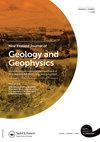托科丸和Ōhāriu北部断层交界处的古地震,对新西兰北岛南部断层相互作用的启示
IF 1.9
4区 地球科学
Q1 GEOLOGY
New Zealand Journal of Geology and Geophysics
Pub Date : 2023-10-09
DOI:10.1080/00288306.2023.2263403
引用次数: 0
摘要
托科丸断层沿新西兰北岛南部西侧延伸。鉴于断层靠近主要的和不断扩大的人口中心,研究人员开展了新的工作,以了解它对威灵顿-列文走廊地震危险的影响。在托科丸断裂带南端,靠近北Ōhāriu断裂带的交界处,挖掘出的两条古地震沟表明,托科丸断裂带和北Ōhāriu断裂带比以前认为的更为活跃。Tokomaru断裂两个最年轻事件的年龄分别为93 ~ 220 calyr BP和1179 ~ 1254 calyr BP,其复发间隔为470 ~ 2300年。这些年龄与Ōhāriu断层上两个最年轻的事件和威灵顿断层上一些事件的时间一致。这表明Tokomaru,北Ōhāriu, Ōhāriu和惠灵顿断层可能在过去一起破裂,相互引发地震,或者由附近更大的地震引发的断层滑动。这项工作的结果说明了北岛南部断层相互作用的重要性,并表明即使这里的断层没有一起破裂,它们也可能在影响彼此的地震行为方面发挥关键作用。关键词:北部Ōhāriu断层tokomaru FaultHorowhenuaKāpiti海岸地震地震海沟复现断层间相互作用感谢Daniel和Rebecca Kilsby-Halliday以及Blair和Anna Robinson允许我们在他们的土地上进行挖掘。这项工作是“这是我们的错”项目的一部分,我们感谢Toka takake EQC、惠灵顿地区管理集团和惠灵顿市议会为这项工作提供资金。该项目由新西兰商业、创新和就业部(MBIE)通过危害和风险管理计划(战略科学投资基金,合同C05X1702)支持。我们还要感谢安迪·多德(Andy Dodd)的考古评估,丹妮尔·威利斯(Danielle Willis)在Makahika的无人机调查中提供的帮助,王宁生博士(Ningsheng Wang)处理OSL样本,以及GNS Rafter实验室的团队对放射性碳样本进行分析。我们感谢Pilar Villamor和Dougal Townsend对本文提供的有用反馈。我们也感谢匿名审稿人和Jack Williams在审稿过程中对本文的有益编辑和评论。数据可用性声明支持本研究结果的数据可在文章及其补充材料中获得,这些数据已上传到Figshare (dx.doi.org/10.6084/m9.figshare.6025748).Disclosure)上。声明作者未报告潜在的利益冲突。这项工作得到了商业、创新和就业部的支持,也得到了“Its Our Fault”的支持。本文章由计算机程序翻译,如有差异,请以英文原文为准。
Paleoearthquakes at the junction of the Tokomaru and Northern Ōhāriu faults, implications for fault interactions in the southern North Island, New Zealand
ABSTRACTThe Tokomaru Fault extends along the west side of the southern North Island of New Zealand. Given the fault’s proximity to major and expanding population centres, new work was undertaken to understand its contribution to seismic hazard in the Wellington-Levin corridor. Two paleoseismic trenches excavated across the southern end of the Tokomaru Fault, close to its junction with the Northern Ōhāriu Fault, show that it and the Northern Ōhāriu Fault are more active than previously thought. Ages of the two youngest events on the Tokomaru Fault are 93–220 and 1179–1254 cal yr BP, and result in a recurrence interval of 470–2300 years. These ages agree with the two youngest events on the Ōhāriu Fault and the timing of some events on the Wellington Fault. This suggests that the Tokomaru, Northern Ōhāriu, Ōhāriu, and Wellington faults may have ruptured together in the past, have triggered earthquakes on each other, or host slip that is triggered by larger nearby earthquakes. The results of this work illustrate the importance of fault interactions in the southern North Island and show that even if faults here do not rupture together, they likely play a key role in influencing the earthquake behaviour of each other.KEYWORDS: Northern Ōhāriu FaultTokomaru FaultHorowhenuaKāpiti Coastearthquakepaleoseismic trenchingrecurrence intervalfault interactions AcknowledgementsWe would like to thank Daniel and Rebecca Kilsby-Halliday, and Blair and Anna Robinson for access and allowing us to excavate on their land. This work was undertaken as part of the It’s Our Fault programme and we are grateful to Toka Tū Ake EQC, the Wellington Regional Management Group and Wellington City Council for funding this work. This project was supported by the New Zealand Ministry of Business, Innovation and Employment (MBIE) through the Hazards and Risk Management programme (Strategic Science Investment Fund, contract C05X1702). We would also like to thank, Andy Dodd for his archaeological assessment, Danielle Willis for help with the UAV survey at Makahika, Dr Ningsheng Wang for processing the OSL samples, and the team in the Rafter Laboratory at GNS for the analysis of radiocarbon samples. We thank Pilar Villamor and Dougal Townsend for their useful feedback on this manuscript. We also thank the anonymous reviewer and Jack Williams for their useful edits and comments on this manuscript during the review process.Data availability statementThe data supporting the findings of this study are available within the article and its supplementary materials, which have been uploaded on Figshare (dx.doi.org/10.6084/m9.figshare.6025748).Disclosure statementNo potential conflict of interest was reported by the author(s).Additional informationFundingThis work was supported by Ministry of Business, Innovation and Employment and also supported by “Its Our Fault”.
求助全文
通过发布文献求助,成功后即可免费获取论文全文。
去求助
来源期刊
CiteScore
5.10
自引率
27.30%
发文量
34
审稿时长
>12 weeks
期刊介绍:
Aims: New Zealand is well respected for its growing research activity in the geosciences, particularly in circum-Pacific earth science. The New Zealand Journal of Geology and Geophysics plays an important role in disseminating field-based, experimental, and theoretical research to geoscientists with interests both within and beyond the circum-Pacific. Scope of submissions: The New Zealand Journal of Geology and Geophysics publishes original research papers, review papers, short communications and letters. We welcome submissions on all aspects of the earth sciences relevant to New Zealand, the Pacific Rim, and Antarctica. The subject matter includes geology, geophysics, physical geography and pedology.

 求助内容:
求助内容: 应助结果提醒方式:
应助结果提醒方式:


